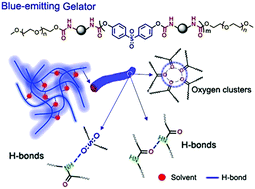Blue-emitting thermoreversible oligourethane gelators with aggregation-induced emission properties†
Abstract
Blue-emitting gels are scarce, especially oligomeric/polymeric systems. Here, a series of 4,4′-sulfonyldiphenol (SDP) based oligourethane derivatives (OUs), namely OUHDI, OUHMDI and OUTDI based on 1,6-hexamethylene diisocyanate, 4,4′-methylenebis(cyclohexyl isocyanate) and 2,4-diisocyanatotoluene, respectively, were rationally designed and obtained by simple procedures. The new oligomers all display aggregation-induced blue fluorescence and upon gelation they achieve enhanced bright deep-blue emission as a result of interchain hydrogen bonding and oxygen cluster interactions. The OUs show spontaneous thermoreversible gelation in solvents which possess hydrogen-bond receptor units (C![[double bond, length as m-dash]](https://www.rsc.org/images/entities/char_e001.gif) O or S
O or S![[double bond, length as m-dash]](https://www.rsc.org/images/entities/char_e001.gif) O) which facilitate self-assembly of the OU chains into nanotubes. The oligourethane gels (OUGs) possess excellent ability for resisting external stress while at the same time exhibiting a distinct viscous flow state. The results illustrate that heteroatomic non-conjugated oligomers with advantageous hydrogen bonding interactions and oxygen clusters provide an efficient route to photoluminescent blue-emitting gels. The thermoreversible OUGs with excellent mechanical properties have been exploited to make sticky coatings, transparent films and a blue fluorescent molded shape using simple fabrication processes.
O) which facilitate self-assembly of the OU chains into nanotubes. The oligourethane gels (OUGs) possess excellent ability for resisting external stress while at the same time exhibiting a distinct viscous flow state. The results illustrate that heteroatomic non-conjugated oligomers with advantageous hydrogen bonding interactions and oxygen clusters provide an efficient route to photoluminescent blue-emitting gels. The thermoreversible OUGs with excellent mechanical properties have been exploited to make sticky coatings, transparent films and a blue fluorescent molded shape using simple fabrication processes.



 Please wait while we load your content...
Please wait while we load your content...